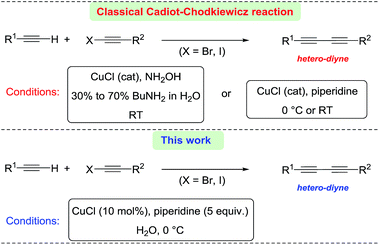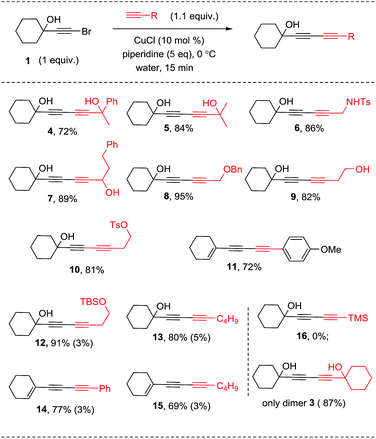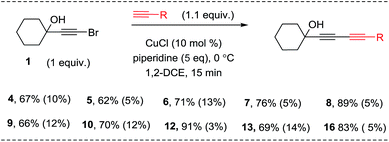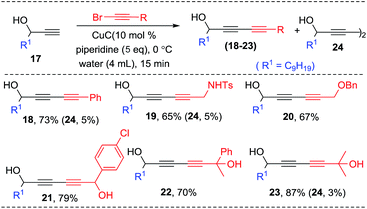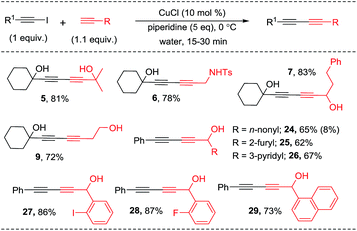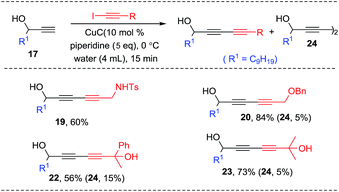A systematic study on the Cadiot–Chodkiewicz cross coupling reaction for the selective and efficient synthesis of hetero-diynes†
Bhavani Shankar Chinta and
Beeraiah Baire*
Department of Chemistry, Institute of Technology Madras, Chennai – 600036, India. E-mail: beeru@iitm.ac.in
First published on 31st May 2016
Abstract
Mild reaction conditions for the Cadiot–Chodkiewicz cross coupling process have been developed for the highly selective and efficient synthesis of unsymmetrical diynes. The most abundant, economic, environmentally friendly, green solvent, water was employed as the sole reaction medium in combination with a minimal amount (5 equiv.) of piperidine base. The reported new reaction conditions provide operational simplicity, high selectivity for hetero coupling (>97%), use of water, and low basicity of the reaction medium compared to commonly used highly basic conditions, i.e., 30–70% amine in water or 100% piperidine. Various sensitive functional groups were found to be highly compatible with the developed low basic reaction conditions. This study supports the fact that the Cadiot–Chodkiewicz cross coupling can be a greener reaction, has a very broad substrate scope, but has always been employed in non-green highly basic conditions and with limited substrate scope.
Introduction
Water is a nontoxic, non-flammable, economic and green solvent, possessing unique properties.1 Many natural and biological transformations have been carried out in water.2 The unique properties of water make it highly appealing for biomimetic synthetic chemistry. Water as a solvent to promote organic transformations has been largely explored in the past two decades due to its fascinating advantages over traditional organic solvents, such as relative abundance, low cost, and non-toxicity.3 The pioneering work of Breslow4 and Sharpless5 inspired the development of catalysis and green protocols in water for the synthesis of highly functionalized and biologically important compounds. Despite these advantages, most of the organic transformations are incompatible with water since most of the organic compounds do not dissolve in water and solubility is generally considered a prerequisite for reactivity.The 1,3-diynes (symmetric and unsymmetrical) and polyynes are very important in synthetic organic and materials chemistry. These are the common structural motifs of a large variety of biologically active natural products6 and supramolecular materials.7 The synthesis of unsymmetrical diynes is more challenging and important as compared to symmetrical diynes in terms of selectivity and applications. The most commonly used procedure for the preparation of unsymmetrical diynes and polyynes is the Cadiot–Chodkiewicz cross-coupling reaction, a copper-catalyzed process between terminal alkynes and haloalkynes (Scheme 1).8
However, though the reaction is successful in many situations,9–11 there are still some disadvantages, such as (a) poor selectivity for heterocoupling (b) basicity of the reaction medium is very high (70% to 100%) and (c) conditions are not very general for divergent substrates. Various modifications have been reported to help in suppressing the formation of the unwanted homocoupled products but they use costly reagents like Pd-catalysts along with Cu and they are very substrate specific etc. In this context, our aim was to develop economic, environmentally friendly, operationally simple and yet highly selective reaction conditions for the Cadiot–Chodkiewicz cross coupling. Here in we report a systematic study on the Cadiot–Chodkiewicz reaction, which resulted in the development of reaction conditions with water as the sole solvent and 5 equivalents of piperidine base, for the highly synthesis of unsymmetrical diynes.
Results and discussion
Initially, we screened divergently polarized organic solvents and water for the reaction (Table 1). We have chosen bromopropargyl alcohol 1 and phenyl acetylene as substrates, piperidine (5 equivalents) as base, CuCl (0.1 eq.) as catalyst and 0 °C temperature as reaction conditions for this study.| S. No | Solvent | Time (min) | Yield of 2b (%) | |
|---|---|---|---|---|
| a All the reactions were carried out with 0.2 mmol of 1 and 0.22 mmol of phenyl acetylene.b Isolated yields after column chromatography.c Numbers in paranthesis are isolated yields of homodimer 3.d CuCl was in 5 mol%.e CuCl was in 20 mol%.f 7 mL of water was used.g 10 mL of water was used.h Normal water from tap. | ||||
| 1 | Piperidine | 30 | 63 (13)c |  |
| 2 | CH2Cl2 | 15 | 68 | |
| 3 | Acetone | 15 | 68 (10)c | |
| 4 | CHCl3 | 15 | 79 | |
| 5 | 1,2-DCE | 15 | 82 | |
| 6 | 1,2-DCB | 15 | 72 | |
| 7 | MeOH | 15 | 63 | |
| 8 | EtOAc | 30 | 54 | |
| 9 | CH3CN | 15 | 77 | |
| 10 | THF | 30 | 52 | |
| 11 | Hexane | 15 | 70 (5)c | |
| 12 | Waterh | 15 | 82 | |
| 13 | Distilled water | 15 | 82 | |
| 14d | Water | 15 | 78 | |
| 15e | Water | 15 | 82 (5) | |
| 16f | Water | 15 | 76 | |
| 17g | Water | 25 | 78 (3) | |
When the reaction was carried out in freshly degassed neat piperidine as in the literature12 (Table 1, entry 1), the cross coupled diyne 2 was formed in 63% yield along with 13% of homodiyne 3. Keeping this outcome as the reference, we next studied various solvents. In dichloromethane (CH2Cl2), with 5 equivalents of piperidine (Table 1, entry 2), the reaction was quicker (15 min) and selective (68%) towards 2, as there was no detection of 3. Acetone was equally good for the formation of 2 but gave about 10% of homodimer 3. Various chlorinated solvents such as CHCl3 (79% of 2), 1,2-dichloroethane (1,2-DCE, 82% of 2), and 1,2-dichlorobenzene (1,2-DCB, 72% of 2) were screened (Table 1, entries 4–6). All of them were found to be highly selective and efficient for the formation of unsymmetrical diyne 2. It is surprising and noteworthy that, in case of all the chlorinated solvents screened, no trace of the 3 was detected. We next carried out this reaction in highly polar solvents like MeOH, EtOAc, CH3CN, and THF (Table 1, entries 7–10 respectively). These solvents with the exception of CH3CN (77%) resulted in a very selective cross coupling reaction but in relatively less yields (52–63%). When hexane, a nonpolar solvent was employed (entry 11), cross coupling was quick and efficient (70%) but gave 5% of homo-coupled diol 3. These observations and outcomes clearly indicate that, there is no need to use the amine base as solvent or in excess amounts during the Cadiot–Chodkiewicz coupling and this reaction can be equally efficient and selective in common organic solvents with few equivalents of amine.
We next carried out this reaction in normal water as well as distilled water to make the process more environmentally benign and economic. To our delight the reaction was highly selective and efficient (82%) for the formation of heterodiyne 2 (Table 1, entries 12 & 13), as compared to any organic solvent. Furthermore, even trace amount of 3 was not detected. We next changed the amount of CuCl employing water as the solvent. In case of 5 mol% (entry 14) the yield of the 2 was reduced on the other hand 20 mol% (entry 15) was equally efficient as 10 mol% but gave 5% of homodimer 3. When we increased the amount of water (entries 16 & 17) from 4 mL to 7 mL, with 5 equivalents of piperidine and 10 mol% of CuCl, the yield of the 2 was reduced (76%), whereas with 10 mL water, reaction was a bit slow and low yielding along with 3% of 3. Hence, among all the solvents screened acetonitrile, chloroform, 1,2-DCE and water were found to be selective and efficient for cross coupling product.
Next screening study for various amine bases was carried out in water and 1,2-DCE by keeping the amount of base as 5 equivalents. When water was employed as the solvent (Table 2A), all the four amine bases screened, such as pyridine, nBuNH2, iPr2NH and Et3N underwent the coupling reaction in about 15–30 min. But, the process was less efficient (57–77% yields of 2) and less selective (6–12% of homo-diynol 3) towards heterodiyne 2 (entries 2–5) compared to piperidine (entry 1). Similar results were observed when the same amines were screened in 1,2-DCE as the solvent (Table 2B). Hence piperidine was found to be the best amine for the Cadiot–Chodkiewicz cross coupling reaction irrespective of the nature of the solvent used.
| A | |||||
|---|---|---|---|---|---|
| S. No | Solvent | Amine | Time (min) | Yield of 2b (%) | Dimmer 3b (%) |
| a Conditions: all the reactions were carried out with 0.2 mmol of 1 and 0.22 mmol of phenyl acetylene, either in degassed water or 1,2-DCE (2 mL/0.1 mmol of 1).b Isolated yields after column chromatography. | |||||
| 1 | Water | Piperidine | 15 | 82 | — |
| 2 | Water | Et3N | 60 | 57 | 12 |
| 3 | Water | iPr2NH | 70 | 66 | 7 |
| 4 | Water | nBuNH2 | 60 | 77 | 7 |
| 5 | Water | Pyridine | 90 | 65 | 6 |
After finding out the best solvent (water) and best amine (piperidine) then we wished to determine the optimal amount of piperidine base required to synthesize hetero-diynes selectively and efficiently. According to the currently existing and well accepted mechanism for Cadiot–Chodkiewicz coupling reaction, at least in one equivalent of base is required. But in the literature, amine is always used either as the solvent or in large excess i.e. at least 20 equivalents. However, use of excess amine base is not adherable and affordable. Hence, we have undertaken this task to reduce the equivalents of amine required for better reaction conditions.
Accordingly, we carried out the reaction in water as well as 1,2-DCE employing piperidine in variable amounts as shown in Table 3A and B. When 1 equiv., of piperidine was employed (Table 3A, entry 1) in water, the reaction was relatively slower (1 h) than with 5 equiv., (Table 3A, entry 4) and resulted in the formation of 65% of 2, and 7% of 3, along with 10% of unreacted bromoalcohol 1.13 In case of 3 equiv., of piperidine (entry 2), the reaction took only 15 min to yield 72% of cross diyne 2 and 5% of homodiyne 3, without any left over starting bromide 1. Surprisingly, 4 equivalents of piperidine afforded 2 as the sole product in 80% isolated yield (entry 3). Surprisingly, increasing amount of piperidine to 7 and 10 equivalents (Table 3A, entries 5 and 6) afforded 3 in comparable yields to 5 equiv., but there was a variable amount of homodimer 3 observed. In continuation, this study was also performed in 1,2-DCE. With 1 equivalent or less amount of piperidine (Table 3B, entries 1–3), the cross coupling was slow (3–5 h, at RT) and less efficient (37–62%) for 2. In these cases, there was always a considerable amount (5–25%) of unreacted bromide 1 and formation of homo dimer 3 (up to 12–15%) was observed. On the other hand, 3 equivalents of piperidine (entry 4), gave 78% yield of 2 and ∼2% of homo dimer 3 within 15 min. Similar to water, 4 equiv. of piperidine in 1,2-DCE (Table 3B, entry 5) resulted in 80% of 2 as the sole product in 15 min at 0 °C. The results and observations from Table 3A and B, clearly sets the lowest limit for the amount of piperidine as 5 equivalents for the quicker, selective, and efficient formation of heterodiynes, both in water as well as in organic solvents (1,2-DCE).
| A | ||||||
|---|---|---|---|---|---|---|
| S. No | Solvent | Piperidine equiv. | Time (h) | 2b (%) | 3b (%) | rsm 1b (%) |
| a Conditions: all the reactions were carried out with 0.2 mmol of 1 and 0.22 mmol of phenyl acetylene, either in degassed water or 1,2-DCE (2 mL/0.1 mmol of 1).b Isolated yields after column chromatography.c 0 °C only.d 0 °C → RT. | ||||||
| 1c | Water | 1.0 | 1 | 65 | 7 | 10 |
| 2c | Water | 3.0 | 1/4 | 72 | 5 | — |
| 3c | Water | 4.0 | 1/4 | 80 | — | — |
| 4c | Water | 5.0 | 1/4 | 82 | — | — |
| 5 | Water | 7.0 | 1/4 | 78 | 8 | — |
| 6 | Water | 10.0 | 1/4 | 81 | 3 | — |
So the best conditions found for the Cadiot–Chodkiewicz cross coupling are water as the solvent, 0 °C as the temperature, and 5 equivalents of piperidine as the base. With an optimized reaction condition in hand, we next performed scope studies for various terminal alkynes and alkynylbromides for the synthesis of structurally divergent heterodiynes. Initially we screened diversely functionalized alkynes keeping the bromide 1 as the coupling partner. Many sensitive functional groups like primary, secondary, tertiary alcohols, amines, OTs and OBn, are compatible under the developed reaction conditions and gave excellent yields of corresponding heterodiynes 4–11, within 15 min and without any traces of homo diynes. Similar alkyne substrates (functional groups) were reported to give very poor yields under classical Cadiot–Chodkiewicz coupling reaction conditions.14 All these divergently functionalized diyne units can be useful synthons for materials possessing excellent electronic and optical properties. When highly non polar groups are present on alkynes, such as OTBS ether and long chain alkyls, 3–5% of homodimer 3 was typically observed though corresponding heterodiynes 12–15 were isolated in good yields (69–91%). But when highly hydrophobic TMS-acetylene was employed as an alkyne partner there was no formation of cross product 16, homo product 3 was isolated instead in 87% yield. This may be due to the poor solubility of TMS-acetylene in water.
To compare the solvent effect i.e., water vs. organic solvents, on reactivity and selectivity, we have also carried out the Cadiot–Chodkiewicz coupling of most of the above substrates in Scheme 2, in 1,2-DCE as shown in Scheme 3. Interestingly, all the substrates afforded good yields of corresponding cross diynes 4–10, 12, 13 & 16 but with relatively lesser selectivity, i.e. variable amounts (3–14%) of homo-coupled product 3 was always observed for all the substrates. Surprisingly and contrary to the outcome in water, coupling of TMS-acetylene with 1 gave excellent yield (83%) of cross diyne 16 and only 5% of homo diyne 3 was detected. These observations proved that water is the best solvent to perform the Cadiot–Chodkiewicz coupling reaction for a majority of substrates including long chain alkynes, with the exception of highly hydrophobic trialkylsilyl acetylenes (1,2-DCE would be a best solvent for them).
In continuation we have also studied the compatibility of variously functionalized alkynyl bromides with the optimized reaction conditions by employing the propargylic alcohol 17 as an alkyne partner (Scheme 4). All the substrates were found to undergo the coupling reaction smoothly in water and resulted in the formation of corresponding cross coupled diynes 18–23 in 65–87% yields along with 3–5% of homo coupling product 24.
In the literature it is found that the bromoalkynes have been employed more frequently in the Cadiot–Chodkiewicz coupling reaction and give better yields than their corresponding iodo- and chloro-counter parts because of their milder reactivity. Hence, after studying the reactivity and substrate scope for various alkynyl bromides, we next turned our attention to observe the reactivity of various alkynyl iodides under our optimized reaction conditions.
Structurally divergent terminal alkynes underwent smooth cross coupling reaction with both the iodocyclohexyl-propargylic alcohol and iodo-phenylacetylene to afford moderate to good yields of corresponding hetero-diynes 5–7, 9 & 25–30 (Scheme 5). Next we performed a scope study for various functionalized iodoacetylenes employing 17 as an alkyne partner (Scheme 6). In all cases the reaction was smooth and afforded corresponding hetero-diynes 19, 20, 22, & 23 in good yields along with variable amounts of homodiyne 24. These experimental results and observations from Schemes 5 & 6, supports the fact that alkynyl iodides can also be employed as suitable partners during the Cadiot–Chodkiewicz cross coupling under our developed reaction conditions, as efficiently as their bromo-counterparts.
Finally, after finding a very good substrate scope for the newly developed, greener reaction conditions for the Cadiot–Chodkiewicz coupling, we aimed to extend it further for triynes and tetraynes as well (Scheme 7). As anticipated triynes 30 & 31 were efficiently (68% & 85%) and selectively prepared under standard conditions from the reaction between alkynyl bromides 1 & 32 and diyne 33. The tetrayne 34 was also synthesized in moderate yield (61%) from two diyne units 33 & 35 and found to be stable under reaction conditions. Quite surprisingly there was no formation of homodimers.
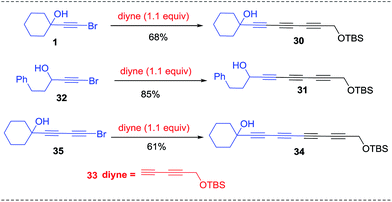 | ||
| Scheme 7 Extension to triynes and tetraynes. Reaction conditions: CuCl (10 mol%); piperidine (5 eq.), 0 °C; water, 30 min. | ||
Conclusions
In conclusion, we have performed a systematic study on Cadiot–Chodkiewicz cross coupling reaction to develop greener, highly selective and efficient reaction conditions for the synthesis of unsymmetrical diynes. The most abundant, most economic and universal solvent water has been employed as the sole reaction medium in combination with 5 equivalents of piperidine base. These conditions offered operational simplicity, very less or no byproducts, use of green solvent water, and use of minimal base. The compatibility of these reaction conditions was tested against various sensitive functional groups, structurally diversified terminal alkynes as well as alkynyl bromides and iodides. The importance of the conditions has also been described by the efficient and selective synthesis of triynes and tetraynes. This study shows that the Cadiot–Chodkiewicz coupling can actually be a greener reaction, has broad scope and can be performed without the use of costly catalysts, highly basic conditions, in contrary to what has been shown so far in the literature.Experimental section
Reactions were monitored by thin-layer chromatography (TLC) carried out on Merck silica plates using UV light and anisaldehyde or potassium permanganate stains for visualization. Column chromatography was performed on silica gel (60–120 mesh) using hexanes and ethyl acetate as eluents. NMR data were recorded on 400 and 500 MHz spectrometers. 13C and 1H chemical shifts in NMR spectra were referenced relative to signals of CDCl3 (δ 7.263 ppm for 1H and 77.16 ppm for 13C). Chemical shifts δ and coupling constants J are given in ppm (parts per million) and Hz (hertz), respectively. Multiplicities were given as: s (singlet); d (doublet); t (triplet); q (quartet); dd (doublets of doublet) or m (multiplets). HRMS were recorded by electron spray ionization (ESI) method on a Q-TOF Micro with lock spray source. Known compounds data have been compared with the reported data, and references were given appropriately. Characterization data for new compounds are given below. 1H and 13C (proton decoupled) NMR spectra for all new compounds are given in the ESI.† Reagents were purchased from chemical companies.General experimental procedure for synthesis of unsymmetrical diynes
To a solution of an alkyne (1 equiv.), and alkynyl bromide (1.1 equiv.) in freshly degassed amine (piperidine) (5 equiv.) and water or organic solvent like 1,2-DCE (4 mL/0.1 mmol) at 0 °C under nitrogen atmosphere, was added CuCl (0.1 equiv.), and the reaction mixture was stirred either at 0 °C or at room temperature for few minutes to several hours. Reaction mixture was diluted with EtOAc (10 mL/0.1 mmol), saturated with aq. NH4Cl (10 mL), and extracted with ethyl acetate (3 × 10 mL). The combined organic layer was washed with brine (10 mL) and dried over MgSO4. Evaporation of the solvent and purification of the crude mixture by flash column chromatography gave the corresponding unsymmetrical diyne.Acknowledgements
This work was supported by Indian Institute of Technology Madras, Chennai, through CHY/13-14/622/NFSC/BEER grant. BSC thanks IIT Madras for HTRA fellowship. We thank Mr Ramkumar for single crystal X-ray analysis.Notes and references
- (a) T. Head-Gordon and G. Hura, Chem. Rev., 2002, 102, 2651 CrossRef CAS PubMed; (b) U. M. Lindstrom, Chem. Rev., 2002, 102, 2751 CrossRef PubMed; (c) Y. Hayashi, Angew. Chem., Int. Ed., 2006, 45, 8103 CrossRef CAS PubMed.
- (a) J. M. Saveant, Energy Environ. Sci., 2012, 5, 7718 RSC; (b) P. Tundo, P. Anastas, D. S. Black, J. Breen, T. Collins, S. Memoli, J. Miyamoto, M. Polyakoff and W. Tumas, Pure Appl. Chem., 2000, 72, 1207 CAS.
- (a) M. B. Gawande, V. D. B. Bonifácio, R. Luque, P. S. Branco and R. S. Varma, Chem. Soc. Rev., 2013, 42, 5522 RSC; (b) R. N. Butler and A. G. Coyne, Chem. Rev., 2010, 110, 6302 CrossRef CAS PubMed; (c) C.-J. Li and L. Chen, Chem. Soc. Rev., 2006, 35, 68 RSC; (d) C.-J. Li, Chem. Rev., 2005, 105, 3095 CrossRef CAS PubMed; (e) U. M. Lindstroem, Chem. Rev., 2002, 102, 2751 CrossRef CAS; (f) J. Mlynarski and S. Bas, Chem. Soc. Rev., 2014, 43, 577 RSC; (g) T. P. Loh and G. L. Chua, Chem. Commun., 2006, 2739 RSC; (h) N. Mase and C. F. Barbas III, Org. Biomol. Chem., 2010, 8, 4043 RSC.
- (a) R. Breslow, Acc. Chem. Res., 1991, 24, 159 CrossRef CAS; (b) R. Breslow, Acc. Chem. Res., 2004, 37, 471 CrossRef CAS PubMed.
- S. Narayan, J. Muldoon, M. G. Finn, V. V. Fokin, H. C. Kolb and K. B. Sharpless, Angew. Chem., Int. Ed., 2005, 44, 3275 CrossRef CAS PubMed.
- (a) R. Jente, P. H. Bonnet and F. Bohlmann, Chem. Ber., 1972, 105, 1694 CrossRef CAS; (b) F. Bohlmann, W. Thefeld and C. Zdero, Chem. Ber., 1970, 103, 2245 CrossRef CAS; (c) A. F. Rose, B. A. Butt and T. Jermy, Phytochemistry, 1980, 19, 563 CrossRef CAS; (d) F. Bohlmann, C. Zdero, H. Robinson and R. M. King, Phytochemistry, 1979, 18, 1519 CrossRef CAS; (e) D. Grandjean, P. Pale and J. Chuche, Tetrahedron, 1993, 49, 5225–5236 CrossRef CAS; (f) N. Fusetani, T. Toyoda, N. Asai, S. Matsunaga and T. Maruyama, J. Nat. Prod., 1996, 59, 796–797 CrossRef CAS PubMed; (g) H. A. Stefani, I. M. Costa and G. Zeni, Tetrahedron Lett., 1999, 40, 9215 CrossRef CAS; (h) X. Fu, F. J. Schmitz and M. Kelly, J. Nat. Prod., 1999, 62, 1336 CrossRef CAS PubMed; (i) G. Zheng, W. Lu and J. Cai, J. Nat. Prod., 1999, 62, 626–628 CrossRef CAS PubMed; (j) S. Ankisetty and M. Slattery, Mar. Drugs, 2012, 10, 1037–1043 CrossRef CAS PubMed; (k) R. Negri, Fitoterapia, 2015, 106, 92 CrossRef CAS PubMed; (l) B. W. Gung, C. R. Chim., 2009, 12, 489 CrossRef CAS; (m) A. L. K. S. Shun and R. R. Tykwinski, Angew. Chem., Int. Ed., 2006, 45, 1034 CrossRef CAS PubMed.
- (a) C. Zhang and C. F. Chen, J. Org. Chem., 2007, 72, 9339 CrossRef CAS PubMed; (b) W. Shi and A. Lei, Tetrahedron Lett., 2014, 55, 2763 CrossRef CAS.
- (a) W. Chodkiewicz and P. Cadiot, C. R. Hebd. Seances Acad. Sci., 1955, 241, 1055 CAS; (b) W. Chodkiewicz, Ann. Chim., 1957, 2, 819 CAS; (c) W. Chodkiewicz and P. Cadiot, C. R. Hebd. Seances Acad. Sci., 1955, 241, 1055 CAS; (d) K. Sonogashira, in Comprehensive Organic Synthesis, ed. B. M. Trost and I. Fleming, Pergamon Press, Oxford, UK, 1991, vol. 3, pp. 551–561 Search PubMed; (e) K. S. Sindhu, A. P. Thankachan, P. S. Sajitha and G. Anilkumar, Org. Biomol. Chem., 2015, 13, 6891 RSC; (f) R. Hua, in Copper-Mediated Cross-Coupling Reactions, John Wiley & Sons Inc., 2013, p. 455 Search PubMed; (g) W. Shi and A. Lei, Tetrahedron Lett., 2014, 55, 2763 CrossRef CAS; (h) T. A. Schaub and M. Kivala, in Metal-Catalyzed Cross-Coupling Reactions and More, Wiley-VCH Verlag GmbH & Co. KGaA, 2014, p. 665 Search PubMed; (i) H. Li, S. Liu and L. S. Liebeskind, in Copper-Mediated Cross-Coupling Reactions, John Wiley & Sons Inc., 2013, p. 485 Search PubMed.
- (a) E.-I. Negishi and L. Anastasia, Chem. Rev., 2003, 103, 1979 CrossRef CAS PubMed; (b) H. Hofmeister, K. Annen, H. Laurent and R. Wiechert, Angew. Chem., Int. Ed. Engl., 1984, 23, 727 CrossRef; (c) B. W. Gung and G. Kumi, J. Org. Chem., 2003, 68, 5956 CrossRef CAS PubMed; (d) B. S. Chinta and B. Baire, J. Org. Chem., 2015, 80, 10208 CrossRef CAS PubMed; (e) J. P. Marino and H. N. Nguyen, J. Org. Chem., 2002, 67, 6841 CrossRef CAS PubMed; (f) M. Alami and F. Ferri, Tetrahedron Lett., 1996, 37, 2763 CrossRef CAS; (g) S. A. Nye and K. T. Potts, Synthesis, 1988, 375 CrossRef CAS; (h) J. Wityak and J. B. Chan, Synth. Commun., 1991, 21, 977 CrossRef CAS; (i) G. C. M. Lee, B. Tobias, J. M. Holmes, D. A. Harcourt and M. E. Garst, J. Am. Chem. Soc., 1990, 112, 9330 CrossRef CAS; (j) W. Shi, Y. Luo, X. Luo, L. Chao, H. Zhang, J. Wang and A. Lei, J. Am. Chem. Soc., 2008, 130, 14713 CrossRef CAS PubMed; (k) Y. Weng, B. Cheng, C. He and A. Lei, Angew. Chem., Int. Ed., 2012, 51, 9547 CrossRef CAS PubMed; (l) C. Amatore, E. Blart, J. P. Genet, A. Jutand, S. Lemaire-Audoire and M. Savignac, J. Org. Chem., 1995, 60, 6829 CrossRef CAS; (m) N. Mukherjee, D. Kundu and B. C. Ranu, Chem. Commun., 2014, 50, 15784 RSC; (n) S. Wang, L. Yu, P. Li, L. Meng and L. Wang, Synthesis, 2011, 1541 CrossRef CAS; (o) H. Li, L. Wang, M. Yang and Y. Qi, Catal. Commun., 2012, 17, 179 CrossRef CAS; (p) H.-F. Jiang and A. Z. Wang, Synthesis, 2007, 1649 CrossRef CAS; (q) J. M. Montierth, D. R. DeMario, M. J. Kurth and N. E. Schore, Tetrahedron, 1998, 54, 11741 CrossRef CAS; (r) E. Barbu and J. Tsibouklis, Tetrahedron Lett., 1996, 37, 5023 CrossRef CAS; (s) D. Grandjean, P. Pale and J. Chuche, Tetrahedron Lett., 1992, 33, 5355 CrossRef CAS; (t) R. Rodriguez-Abad and J. Tsibouklis, Synth. Commun., 1998, 28, 4333 CrossRef CAS; (u) L. Fomina, A. Vega, S. Fomine, R. Gaviño and T. Ogawa, Macromol. Chem. Phys., 1996, 197, 2653 CrossRef CAS; (v) F. Babudri, L. Di Nunno and S. Florio, Synthesis, 1983, 230 CrossRef CAS; (w) M. Rösner and G. Köbrich, Angew. Chem., Int. Ed. Engl., 1975, 14, 708 CrossRef.
- (a) M. D. Mowery and C. E. Evans, Tetrahedron Lett., 1997, 38, 11 CrossRef CAS; (b) L. Blanco, H. E. Helson, M. Hirthammer, H. Mestdagh, S. Spyroudis and K. P. C. Vollhardt, Angew. Chem., Int. Ed. Engl., 1987, 26, 1246 CrossRef; (c) D. W. Wiley, J. C. Calabrese, R. L. Harlow and J. S. Miller, Angew. Chem., Int. Ed. Engl., 1991, 30, 450 CrossRef; (d) Y. Nishihara, K. Ikegashira, A. Mori and T. Hiyama, Tetrahedron Lett., 1998, 39, 4075 CrossRef CAS; (e) R. Eastmond and D. R. M. Walton, Tetrahedron, 1972, 28, 4591 CrossRef CAS; (f) J. P. Marino and H. N. Nguyen, J. Org. Chem., 2002, 67, 6841 CrossRef CAS PubMed; (g) Y. Rubin, T. C. Parker, S. I. Khan, C. L. Holliman and S. W. McElvany, J. Am. Chem. Soc., 1996, 118, 5308 CrossRef CAS; (h) M. L. Bell, R. C. Chiechi, C. A. Johnson, D. B. Kimball, A. J. Matzger, W. Brad Wan, T. J. R. Weakley and M. M. Haley, Tetrahedron, 2001, 57, 3507 CrossRef CAS; (i) F. Cataldo, L. Ravagnan, E. Cinquanta, I. E. Castelli, N. Manini, G. Onida and P. Milani, J. Phys. Chem. B, 2010, 114, 14834 CrossRef CAS PubMed; (j) M. Yu, D. Pan, W. Jia, W. Chen and N. Jiao, Tetrahedron Lett., 2010, 51, 1287 CrossRef CAS; (k) T. Gibtner, F. Hampel, J. P. Gisselbrecht and A. Hirsch, Chem.–Eur. J., 2002, 8, 408 CrossRef CAS PubMed; (l) A. Bandyopadhyay, B. Varghese and S. Sankararaman, J. Org. Chem., 2006, 71, 4544 CrossRef CAS PubMed; (m) A. L. K. Shi Shun and R. R. Tykwinski, Angew. Chem., Int. Ed., 2006, 45, 1034 CrossRef PubMed; (n) S. López, F. Fernández-Trillo, P. Midón, L. Castedo and C. Saá, J. Org. Chem., 2005, 70, 6346 CrossRef PubMed; (o) S. López, F. Fernández-Trillo, L. Castedo and C. Saá, Org. Lett., 2003, 5, 3725 CrossRef PubMed; (p) H. Yun and S. J. Danishefsky, J. Org. Chem., 2003, 68, 4519 CrossRef CAS PubMed; (q) Y.-Q. Yang, S.-N. Li, J.-C. Zhong, Y. Zhou, H.-Z. Zeng, H.-J. Duan, Q.-H. Bian and M. Wang, Tetrahedron: Asymmetry, 2015, 26, 361 CrossRef CAS; (r) G. Zheng, W. Lu and J. Cai, J. Nat. Prod., 1999, 62, 626 CrossRef CAS PubMed; (s) F. Bellina, A. Carpita, L. Mannocci and R. Rossi, Eur. J. Org. Chem., 2004, 2610 CrossRef CAS; (t) B. W. Gung and H. Dickson, Org. Lett., 2002, 4, 2517 CrossRef CAS PubMed; (u) Y. Wang, Q.-F. Liu, J.-J. Xue, Y. Zhou, H.-C. Yu, S.-P. Yang, B. Zhang, J.-P. Zuo, Y. Li and J.-M. Yue, Org. Lett., 2014, 16, 2062 CrossRef CAS PubMed; (v) N. Kumar Bejjanki, A. Venkatesham, K. Balraju and K. Nagaiah, Helv. Chim. Acta, 2013, 96, 1571 CrossRef CAS.
- (a) B. V. S. Reddy, R. Nageshwar Rao, B. Kumaraswamy and J. S. Yadav, Tetrahedron Lett., 2014, 55, 4590 CrossRef CAS; (b) H. A. Stefani, P. H. Menezes, I. M. Costa, D. O. Silva and N. Petragnani, Synlett, 2002, 1335 CrossRef CAS; (c) A. Carpita, S. Braconi and R. Rossi, Tetrahedron: Asymmetry, 2005, 16, 2501 CrossRef CAS; (d) H. Takamura, H. Wada, N. Lu, O. Ohno, K. Suenaga and I. Kadota, J. Org. Chem., 2013, 78, 2443 CrossRef CAS PubMed; (e) A. Sathish Reddy and P. Srihari, Tetrahedron Lett., 2013, 54, 6370 CrossRef CAS; (f) P. García-Domínguez, R. Alvarez and Á. R. de Lera, Eur. J. Org. Chem., 2012, 4762 CrossRef; (g) J. S. Yadav, E. J. Reddy and T. Ramalingam, New J. Chem., 2001, 25, 223 RSC; (h) R. Mozuraitis, V. Buda, I. Liblikas, C. R. Unelius and A. K. B. Karlson, J. Chem. Ecol., 2002, 28, 1191 CrossRef CAS PubMed; (i) M. J. Chmielewski, J. J. Davis and P. D. Beer, Org. Biomol. Chem., 2009, 7, 415 RSC; (j) J. Berná, S. M. Goldup, A. L. Lee, D. A. Leigh, M. D. Symes, G. Teobaldi and F. Zerbetto, Angew. Chem., Int. Ed., 2008, 47, 4392 CrossRef PubMed; (k) S. M. Goldup, D. A. Leigh, T. Long, P. R. McGonigal, M. D. Symes and J. Wu, J. Am. Chem. Soc., 2009, 131, 15924 CrossRef CAS PubMed; (l) M. Santella, V. Mazzanti, M. Jevric, C. R. Parker, S. L. Broman, A. D. Bond and M. B. Nielsen, J. Org. Chem., 2012, 77, 8922 CrossRef CAS PubMed; (m) M. A. Heuft, S. K. Collins and A. G. Fallis, Org. Lett., 2003, 5, 1911 CrossRef CAS PubMed; (n) T. R. Hoye, B. Baire, D. Niu, P. H. Willoughby and B. P. Woods, Nature, 2012, 490, 208 CrossRef CAS PubMed; (o) B. Baire, D. Niu, P. H. Willoughby, B. P. Woods and T. R. Hoye, Nat. Protoc., 2013, 8, 501 CrossRef CAS PubMed; (p) S. L. Broman, M. Jevric, A. D. Bond and M. B. Nielsen, J. Org. Chem., 2014, 79, 41 CrossRef CAS PubMed; (q) D. B. Kimball, M. M. Haley, R. H. Mitchell, T. R. Ward, S. Bandyopadhyay, R. V. Williams and J. R. Armantrout, J. Org. Chem., 2002, 67, 8798 CrossRef CAS PubMed; (r) S. I. Kato, N. Takahashi and Y. Nakamura, J. Org. Chem., 2013, 78, 7658 CrossRef CAS PubMed; (s) N. F. Utesch and F. Diederich, Org. Biomol. Chem., 2003, 1, 237 RSC; (t) P. C. Cadiot and W. Chodkiewicz, Chemistry in Acetylenes, 1969, p. 597 Search PubMed.
- (a) M. Alami and F. Ferri, Tetrahedron Lett., 1996, 37, 2763 CrossRef CAS; (b) G. A. Kraus, J. Bae, L. Wu and E. Wurtele, Molecules, 2006, 11, 758 CrossRef CAS PubMed; (c) N. Danilkina, M. Nieger, S. Selivanov, S. Bräse and I. Balova, Eur. J. Org. Chem., 2012, 5660 CrossRef CAS.
- Even after stirring the reaction mixture for 2 more hours there was no consumption of stating material 1.
- (a) E. Barbu and J. Tsibouklis, Tetrahedron Lett., 1996, 37, 5023 CrossRef CAS; (b) D. Grandjean, P. Pale and J. Chuche, Tetrahedron Lett., 1992, 33, 5355 CrossRef CAS; (c) R. Rodriguez-Abad and J. Tsibouklis, Synth. Commun., 1998, 28, 4333 CrossRef CAS.
Footnote |
| † Electronic supplementary information (ESI) available. See DOI: 10.1039/c6ra07308e |
| This journal is © The Royal Society of Chemistry 2016 |

